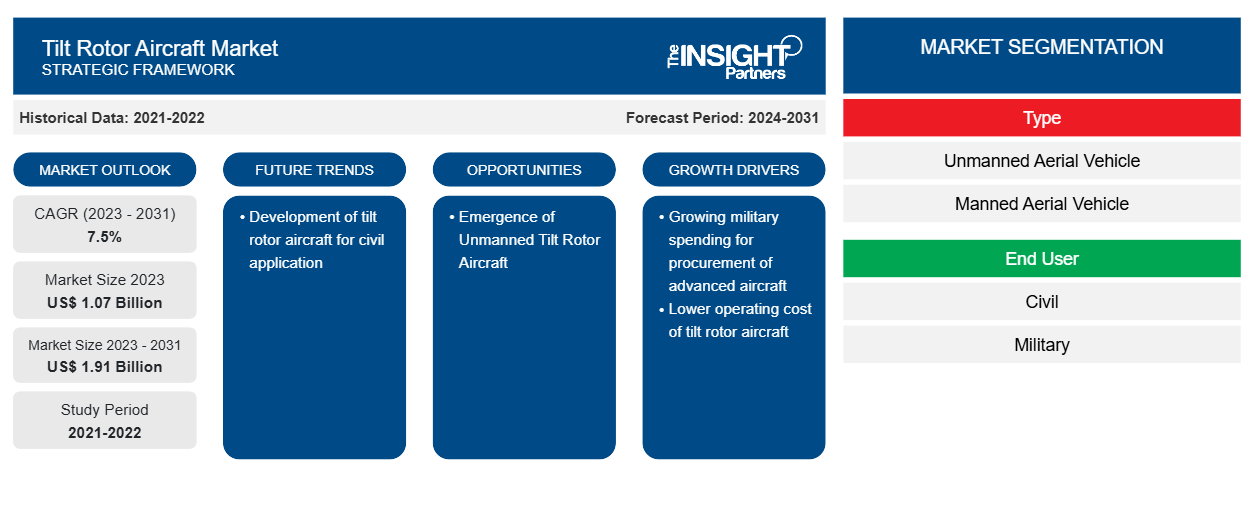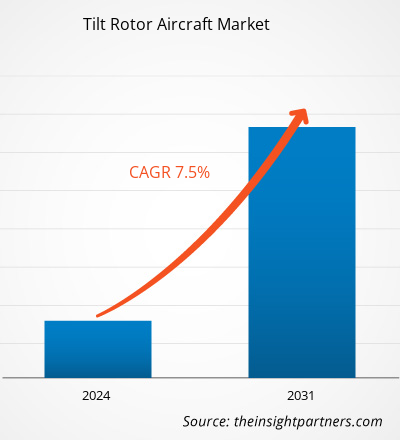The tilt rotor aircraft market size is projected to reach US$ 1.91 billion by 2031 from US$ 1.07 billion in 2023. The market is expected to register a CAGR of 7.5% during 2023–2031. Development of tilt rotor aircraft for civil application is likely to remain a key trend in the market.
Tilt Rotor Aircraft Market Analysis
The tilt rotor aircraft market players are experiencing significant business growth year-on-year. This is mainly attributed to the rise in the number of end users. The increase in the procurement of tilt rotor aircraft for military and civil application is gradually promoting the bargaining power of the suppliers. At present, the bargaining power of tilt rotor aircraft suppliers is moderate, however, it is expected to drop to low levels, as the end users are increasing, and the models are built with similar specifications. The increase in number of end users majorly pertains to the rise in development of unmanned tilt rotor aircraft models for civilian as well as military applications.
Tilt Rotor Aircraft Market Overview
Manned ariel vehicles and unmanned ariel vehicles are the two types of tilt rotor aircraft offered in the market. The number of manufacturers of manned tilt rotor aircraft are relatively low. At present, the manned tilt rotor aircraft models are available with the US defense forces and Japanese defense force. The cost of the manned tilt rotors is one of the major factors for lower demand. However, with the commercialization of Leonardo’s AW609 tilt-rotor aircraft, which is approximately US$ 40 million less costly than the V-22 Osprey, would encourage buyers to procure manned tilt rotor aircraft. This factor is analyzed to understand and portray the bargaining power of buyers in the coming years. Moreover, the vendors operating in the tilt rotor aircraft market are also majorly focusing on the development of new and innovative products to remain competitive in the market.
Customize This Report To Suit Your Requirement
You will get customization on any report - free of charge - including parts of this report, or country-level analysis, Excel Data pack, as well as avail great offers and discounts for start-ups & universities
Tilt Rotor Aircraft Market: Strategic Insights

-
Get Top Key Market Trends of this report.This FREE sample will include data analysis, ranging from market trends to estimates and forecasts.
Tilt Rotor Aircraft Market Drivers and Opportunities
Growing Military Spending for Procurement of Advanced Aircraft
As global tensions have persisted over the last few years, various affected nations plan and take measures to improve and recapitalize the defense status. Threats are continually evolving, i.e., from the conventional land-based force on force to hybrid warfare. To address security threats and tackle terrorism, governments of several nations have already started to increase their defense budgets. According to the Stockholm International Peace Research Institute (SIPRI), the global military expenditure rose to US$ 2,443 billion in 2023, which represents 13.7% increase from 2022.
The increasing geopolitical tensions and wars among some of the countries of different regions are driving high investments in the defense sector. A significant portion of the investment is dedicated for the procurement of advanced military aircraft and tilt rotor aircraft. For instance, in May 2023, Boeing received a contract worth US$ 482.3 million for the production and delivery of four CMV-22B (Lot 27) aircraft for the US Naval forces. Thus, the growing procurement of tilt rotor aircraft for military application is projected to drive the growth of the market during the forecast period.
Emergence of Unmanned Tilt Rotor Aircraft
The rapid change in modern warfare has been urging the governments to allocate higher funds toward respective armed forces. The higher military budget allocation enables the military forces to engage themselves in the development and procurement of advanced warfare fleets including UAV. The UAV is widely used for gathering intelligence, surveillance, reconnaissance, target acquisition, battle damage management, delivery, transportation, combat operations, and other applications. Ministries across the world are investing substantial amounts intending to modernize armed forces. At present, fleet modernization is among the most observed practices followed by the aerospace and defense industry. Companies such as Textron Inc., China Aerospace Science and Technology Corp., and BNA – Nurol BAE Systems Air Systems Inc. are offering unmanned ariel vehicles (UAV). As the future of ariel warfare is gradually shifting from manned ariel vehicles to unmanned ariel vehicles, the tilt rotor aircraft market players are projected to witness significant growth opportunities during the forecast period.
Tilt Rotor Aircraft Market Report Segmentation Analysis
Key segments that contributed to the derivation of the tilt rotor aircraft market analysis are type and end user.
- Based on type, the tilt rotor aircraft market is segmented into unmanned aerial vehicle and manned aerial vehicle. The manned aerial vehicle segment held a larger market share in 2023.
- Based on end user, the tilt rotor aircraft market is segmented into civil and military. The military segment held a larger market share in 2023.
Tilt Rotor Aircraft Market Share Analysis by Geography
The geographic scope of the tilt rotor aircraft market report is mainly divided into four regions: North America, Europe, Asia Pacific, and Rest of the World.
North America has dominated the market in 2023 followed by Asia Pacific and Europe regions. Further, North America is also likely to witness the highest CAGR in the coming years. The US accounted for the largest market share in North America's tilt rotor aircraft market. The US is the world’s leading defense spender in the world and has the largest military aircraft fleet in the world. The US government is also known for supporting research and development of advanced aircraft and weaponry systems. Currently, the country has the largest fleet of tilt rotor aircraft, V-22 Osprey, which is used by the US Air Force, US Navy, and US Marine Corps. The V-22 Osprey is expected to continue to dominate the tilt rotor aircraft market during the forecast period. Moreover, the country is known known for procuring a high number of advanced unmanned ariel vehicles.
Tilt Rotor Aircraft Market Regional Insights
The regional trends and factors influencing the Tilt Rotor Aircraft Market throughout the forecast period have been thoroughly explained by the analysts at The Insight Partners. This section also discusses Tilt Rotor Aircraft Market segments and geography across North America, Europe, Asia Pacific, Middle East and Africa, and South and Central America.
Tilt Rotor Aircraft Market Report Scope
| Report Attribute | Details |
|---|---|
| Market size in 2023 | US$ 1.07 Billion |
| Market Size by 2031 | US$ 1.91 Billion |
| Global CAGR (2023 - 2031) | 7.5% |
| Historical Data | 2021-2022 |
| Forecast period | 2024-2031 |
| Segments Covered |
By Type
|
| Regions and Countries Covered |
North America
|
| Market leaders and key company profiles |
|
Tilt Rotor Aircraft Market Players Density: Understanding Its Impact on Business Dynamics
The Tilt Rotor Aircraft Market is growing rapidly, driven by increasing end-user demand due to factors such as evolving consumer preferences, technological advancements, and greater awareness of the product's benefits. As demand rises, businesses are expanding their offerings, innovating to meet consumer needs, and capitalizing on emerging trends, which further fuels market growth.

- Get the Tilt Rotor Aircraft Market top key players overview
Tilt Rotor Aircraft Market News and Recent Developments
The tilt rotor aircraft market is evaluated by gathering qualitative and quantitative data post primary and secondary research, which includes important corporate publications, association data, and databases. A few of the developments in the tilt rotor aircraft market are listed below:
- Textron Inc (NYSE: TXT) announced today that Bell Textron Inc., a Textron company, has been awarded the development contract for the U.S. Army’s Future Long-Range Assault Aircraft (FLRAA) program. The award is based on Bell’s V-280 Valor tiltrotor that was developed and tested as part of the Joint Multi-Role Technology Demonstrator (JMR TD) program that began in 2013. The V-280 progressed through design, manufacturing, and more than three years of rigorous flight testing that provided extensive data validating the technical and operational advantages of the aircraft for the long-range assault mission. (Source: Textron Inc, Press Release, Feb 2022)
- Russia’s ZALA Aero Unveils Tilt rotor, hybrid-power Drones. The tilt rotor ZALA VTOL combines the best qualities of an aircraft-type drone and a tilt rotor, and also has the ability to change the configuration depending upon the task being performed (Source: ZALA Aero, Press Release, Apr 2021)
Tilt Rotor Aircraft Market Report Coverage and Deliverables
The “Tilt Rotor Aircraft Market Size and Forecast (2021–2031)” report provides a detailed analysis of the market covering below areas:
- Tilt rotor aircraft market size and forecast at global, regional, and country levels for all the key market segments covered under the scope
- Tilt rotor aircraft market trends as well as market dynamics such as drivers, restraints, and key opportunities
- Detailed porter’s five forces analysis
- Tilt rotor aircraft market analysis covering key market trends, global and regional framework, major players, regulations, and recent market developments
- Industry landscape and competition analysis covering market concentration, heat map analysis, prominent players, and recent developments for the tilt rotor aircraft market
- Detailed company profiles
Frequently Asked Questions
Which region dominated the tilt rotor aircraft market in 2023?
What are the driving factors impacting the tilt rotor aircraft market ?
What are the future trends of the tilt rotor aircraft market ?
Which are the leading players operating in the tilt rotor aircraft market ?
What would be the estimated value of the tilt rotor aircraft market by 2031?
What is the expected CAGR of the tilt rotor aircraft market ?
- Historical Analysis (2 Years), Base Year, Forecast (7 Years) with CAGR
- PEST and SWOT Analysis
- Market Size Value / Volume - Global, Regional, Country
- Industry and Competitive Landscape
- Excel Dataset
Recent Reports
Testimonials
Reason to Buy
- Informed Decision-Making
- Understanding Market Dynamics
- Competitive Analysis
- Identifying Emerging Markets
- Customer Insights
- Market Forecasts
- Risk Mitigation
- Boosting Operational Efficiency
- Strategic Planning
- Investment Justification
- Tracking Industry Innovations
- Aligning with Regulatory Trends





















 Get Free Sample For
Get Free Sample For